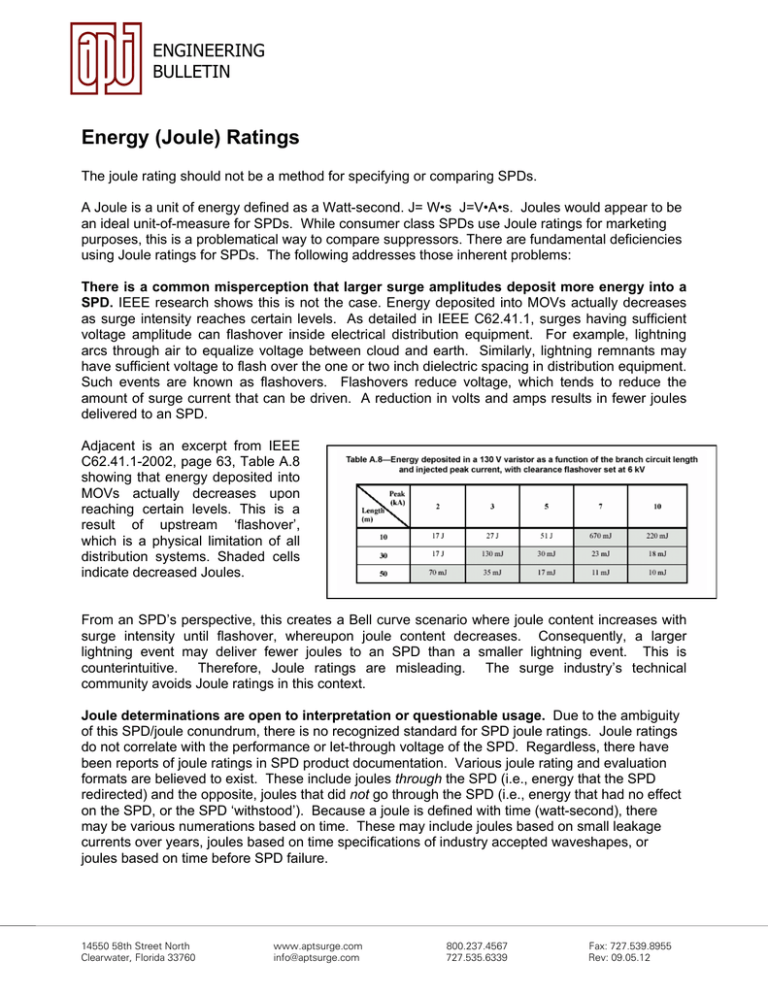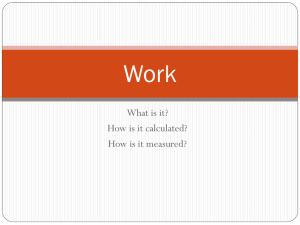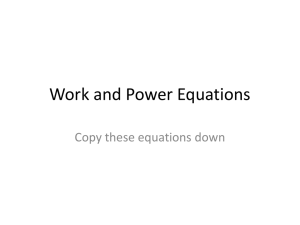Energy (Joule) Ratings
advertisement

ENGINEERING BULLETIN Energy (Joule) Ratings The joule rating should not be a method for specifying or comparing SPDs. A Joule is a unit of energy defined as a Watt-second. J= W•s J=V•A•s. Joules would appear to be an ideal unit-of-measure for SPDs. While consumer class SPDs use Joule ratings for marketing purposes, this is a problematical way to compare suppressors. There are fundamental deficiencies using Joule ratings for SPDs. The following addresses those inherent problems: There is a common misperception that larger surge amplitudes deposit more energy into a SPD. IEEE research shows this is not the case. Energy deposited into MOVs actually decreases as surge intensity reaches certain levels. As detailed in IEEE C62.41.1, surges having sufficient voltage amplitude can flashover inside electrical distribution equipment. For example, lightning arcs through air to equalize voltage between cloud and earth. Similarly, lightning remnants may have sufficient voltage to flash over the one or two inch dielectric spacing in distribution equipment. Such events are known as flashovers. Flashovers reduce voltage, which tends to reduce the amount of surge current that can be driven. A reduction in volts and amps results in fewer joules delivered to an SPD. Adjacent is an excerpt from IEEE C62.41.1-2002, page 63, Table A.8 showing that energy deposited into MOVs actually decreases upon reaching certain levels. This is a result of upstream ‘flashover’, which is a physical limitation of all distribution systems. Shaded cells indicate decreased Joules. From an SPD’s perspective, this creates a Bell curve scenario where joule content increases with surge intensity until flashover, whereupon joule content decreases. Consequently, a larger lightning event may deliver fewer joules to an SPD than a smaller lightning event. This is counterintuitive. Therefore, Joule ratings are misleading. The surge industry’s technical community avoids Joule ratings in this context. Joule determinations are open to interpretation or questionable usage. Due to the ambiguity of this SPD/joule conundrum, there is no recognized standard for SPD joule ratings. Joule ratings do not correlate with the performance or let-through voltage of the SPD. Regardless, there have been reports of joule ratings in SPD product documentation. Various joule rating and evaluation formats are believed to exist. These include joules through the SPD (i.e., energy that the SPD redirected) and the opposite, joules that did not go through the SPD (i.e., energy that had no effect on the SPD, or the SPD ‘withstood’). Because a joule is defined with time (watt-second), there may be various numerations based on time. These may include joules based on small leakage currents over years, joules based on time specifications of industry accepted waveshapes, or joules based on time before SPD failure. 14550 58th Street North Clearwater, Florida 33760 www.aptsurge.com info@aptsurge.com 800.237.4567 727.535.6339 Fax: 727.539.8955 Rev: 09.05.12 ENGINEERING BULLETIN For example, the first calculation below shows Joules when the SPD gets ‘clobbered’ by IEEE C62.41’s most severe surge. The second calculation shows trivial leakage currents for a little over six months. Joule ratings are the same but the stress on the SPD is very different. Assume IEEE worst case surge: C High - 10,000V, 10,000A, 20s duration: J= W•s = V•A•s = 10,000V x 10,000A x 20s = 2,000J Assume 1A leakage current through 120V MOV(s) for 193 days: J= W•s = V•A•s = 120V x 1A x 193 days = 2,001J In another example, can the SPD sustain a “Joule rating” many times, one time, or does it define failure? At least one manufacturer uses a “multiplier”. For example, if an MOV is rated 1J, but can withstand 5,000 hits, the SPD is rated 1J x 5,000 = 5,000 Joules. Additional variants include differences involving rms or peak value usage, theoretical calculations compared to actual testing, context of ratings labeled “typical”, rating of the entire SPD versus ‘per mode’ or ‘per phase’ and various subjective qualities. Also note that it is not possible to compare joule ratings of voltage limiting components to voltage switching components. For these reasons, joule ratings are not accepted as a method of comparing SPDs and are not recognized by surge suppression Standards due to ambiguity. For further information or an IEEE white paper titled, “No Joules for Surges: Relevant and Realistic Assessment of Surge Stress Threats”, please contact APT Engineering Sales Department at 800237-4567, or email: info@apttvss.com. APT Engineering Sales 14550 58th Street North Clearwater, Florida 33760 www.aptsurge.com info@aptsurge.com 800.237.4567 727.535.6339 Fax: 727.539.8955 Rev: 09.05.12



